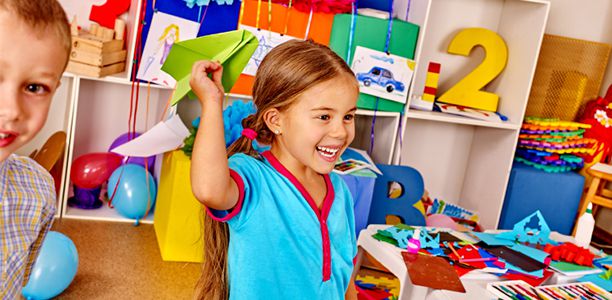Body movement can boost children’s learning, especially when integrated into the classroom as part of a learning task.
Children who physically act out a new concept learn more and have better academic outcomes, new research suggests.
The research, from UOW’s Early Start Research Institute (ESRI), was recently published in a special edition of the journal Educational Psychology Review, which was edited by Early Start’s executive director Professor Paul Chandler. The study found that children who enacted foreign language words through whole-body movements performed better at the end of the course.
The study involved 111 preschool children from 15 childcare centres across NSW learning 14 Italian words over a four-week period.
The results showed those who physically acted out movements (for example, dance, jump, or catch) while being shown a flash card were more likely to remember the corresponding Italian word.
Professor Fred Paas, who co-authored the paper with UOW PhD student Myrto-Foteini Mavilidi and others at ESRI, said the results show the multi-faceted benefit of this type of learning.
“Not only did this way of learning prove more effective, it was also more enjoyable for children. And most importantly, it got kids moving, which is not only good for their physical health, it’s also important for their brain development.”
Professor Paas said research suggests that school aged children who are more active score better on perceptual skills, verbal and maths tests and have a higher level of academic readiness than less active children.
“The most effective way to create new neurons and synapses in the brain appears to be physical activity. This is especially important in children, whose nervous system is highly malleable.
“And because children have a physiological need to burn energy and move around, a blend of physical and cognitive components can help preserve their motivation for learning.
“Surprisingly however, the time spent on physical activities in schools is actually declining, most likely due to the schools’ general concern that time for physical activities is associated with a loss of academic time.”
Professor Paas, from the School of Psychology within UOW’s Faculty of Social Sciences, has just been named the most productive educational psychology researcher in the world. The ranking is based on publications over the past five years in the five best educational psychology journals and is produced by Springer.
In the early 1990s, Professor Paas helped pioneer cognitive load theory, the study of how people’s memory capacity can be instructionally managed to learn effectively, and has since published some 200 journal articles and book chapters, with 19,000 citations, and has been awarded more than $8million in research grants.
In a related recent study further exploring the effect of movements on learning and performance in primary school children in Years 3 and 4 (conducted in Southern Sydney), Professor Paas, with Dr Shirley Agostinho, Dr Sharon Tindall-Ford and ESRI colleagues, showed that finger tracing of learning tasks on an iPad helped children understand and interpret temperature graphs better than those who did not.
Although this ‘tracing effect’ has also been found for paper-based materials, Professor Paas said the results support previous evidence that interactive ‘intuitive technology’ that affords tracing movements, such as tablet-PCs, could actually be used in the classroom to enrich learning.
“Taking action in response to information, in addition to simply seeing or hearing it, creates a richer memory and supplies alternative avenues for recalling the memory later on,” Professor Paas said.
“Hence, if used in particular ways, interactive technologies, such as iPads, in the classroom can actively enhance learning.”
(Source: University of Wollongong, Educational Psychology Review)










